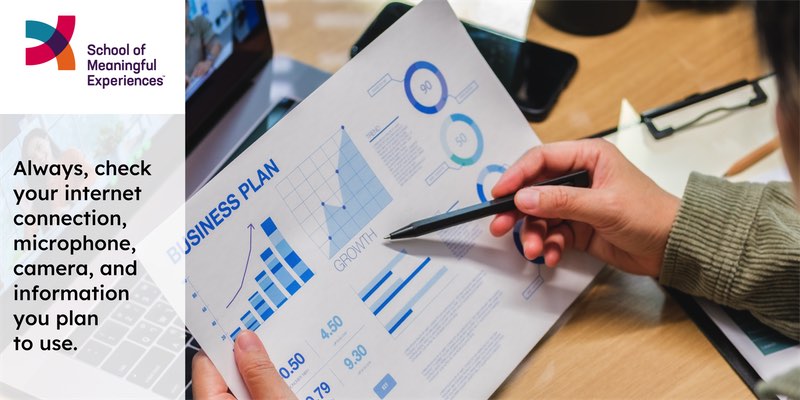After COVID, with more companies embracing the WFH hybrid model of working, virtual presentations have become a fundamental part of professional communication. Whether you're an executive delivering a keynote or a sales representative pitching a product, mastering the art of giving a remote presentation is vital for success.
This blog post explores the ten virtual presentation tips that will enhance your virtual communication skills. This comprehensive guide offers valuable insights and practical virtual presentation tips. So, get ready to take your virtual presentations from good to great!
Importance of Following Best Practices for a Flawless Virtual Presentation
Virtual presentations require a different skill set compared to in-person presentations. The presenter needs to capture and hold the audience's attention while talking. Shorter sentences are easier to understand, and maintaining eye contact with the audience through the webcam is crucial.
Additionally, using appropriate hand gestures, facial expressions, and body language can help to keep the audience engaged and connected. Following best practices for virtual presentations will help ensure your audience effectively communicates and receives your message.
Virtual Presentation Examples
To illustrate the best practices for a flawless remote presentation, let's look at some virtual presentation examples:
- A salesperson presenting a product demonstration to a potential client via Zoom
- A teacher delivering a lecture to students via Microsoft Teams
- A manager giving a team update during a Google Meet conference call
- A keynote speaker presenting at a virtual conference via Webex
How to Give a Virtual Presentation: 10 Best Practices to Follow

1. Test Your Technology
Before your presentation, make sure to test your technology. Check your internet connection, microphone, camera, and any other tools you plan to use. It's essential to ensure that everything is working correctly before starting your presentation to avoid any technical difficulties during the presentation.
2. Create a Professional Environment
Your present environment should be professional and appropriate for the message you want to convey. Choose a quiet, well-lit space with a neutral background to minimise distractions. Make sure your surroundings are tidy and uncluttered, and remove anything distracting or inappropriate.
3. Dress Appropriately
Even though you're presenting remotely, it's still important to dress appropriately for the occasion. Dressing professionally helps to convey respect for your audience and your message. Avoid wearing bright colours or patterns that might be distracting on camera.
4. Use Engaging Visuals
Visual aids can be an effective way to communicate your message and keep your audience engaged. Use graphics, charts, images, and videos to help illustrate your points and make your presentation more interesting. However, ensure your visuals are relevant and easy to understand and don't distract from your message.
5. Speak Clearly and Slowly
When presenting remotely, it's essential to speak clearly and slowly to ensure your audience understands you. Take regular breaks to allow your audience to process the information and ask questions if necessary. Try to avoid using jargon or technical terms that your audience might not understand.
6. Avoid Distractions
Minimise distractions during your presentation by muting notifications and closing other applications on your computer.
If you're presenting, choose a quiet and private room where you won't be interrupted by external noises. You can also politely ask your audience to refrain from using their phones or engaging in conversations without turning off their microphone during the presentation.
Additionally, ensure you have all the materials you need ready and organised beforehand to avoid any last-minute distractions or technical difficulties. Remember, the more focused you are, your audience will be more engaged and attentive.
7. Be Prepared for Technical Difficulties
Technical difficulties can still occur during a remote presentation despite your best efforts. Be prepared to troubleshoot any issues that arise, and have a backup plan in case your primary tools fail. It's also essential to have a contact person who can help you resolve any technical issues if necessary.
8. Practise Your Timing
Time management is essential during a virtual presentation. Plan your presentation carefully and practise your timing to ensure that you stay within the allotted time. Remember to leave time for questions and answers at the end of your presentation.
9. Interact with Your Audience
Engage your audience by asking questions, encouraging discussion, and soliciting feedback. Use polls, quizzes, and surveys to make the presentation interactive and engage your audience. If possible, address your audience by name, and make eye contact with the camera periodically to create a more personal connection.
10. Follow Up After the Presentation
After your presentation, follow up with your audience to gather feedback and address any outstanding questions or concerns. Use this feedback to improve your future presentations and strengthen your relationship with your audience.
Additionally, following up with your audience after a presentation is an excellent way to show your appreciation for their time and attention. A simple thank-you message or email can go a long way in establishing a positive relationship with your audience and keeping them engaged.
Conclusion
By implementing these ten best practices for a flawless remote presentation, you can enhance your virtual communication skills and make a lasting impact on your audience. Remember to prepare thoroughly, pay attention to your delivery, and utilise visual aids strategically to create a seamless virtual experience.
To further sharpen your presentation skills and excel in the virtual realm, consider exploring professional courses and workshops offered by SoME. Our comprehensive programmes cover various topics, including virtual presentation tips, mastering presentation remotes, and techniques for delivering captivating virtual presentations.




















